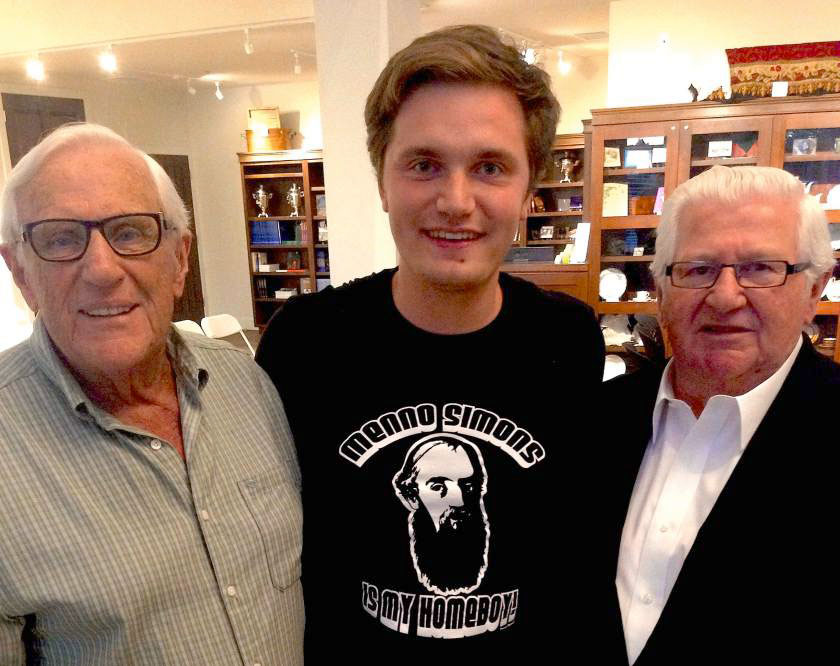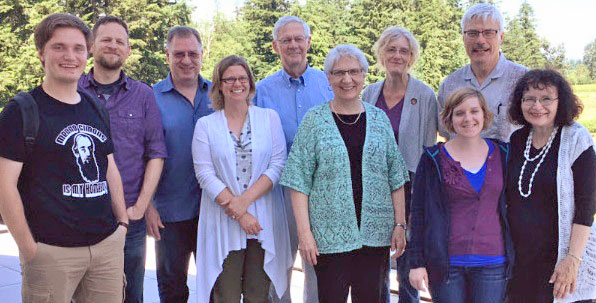This spring I was awarded an archival internship with the Mennonite Brethren Historical Commission that allowed me to travel to various Mennonite Brethren archives in North America to learn how they work, as well as to do some of my own research.
I visited the archives at the Mennonite Heritage Museum in Abbotsford, B.C.; the Hiebert Library at Fresno Pacific University in Fresno, Calif.; the Center for Mennonite Brethren Studies at Tabor College in Hillsboro, Kan.; and the Centre for Mennonite Brethren Studies in Winnipeg, spending a week in each place.
I focussed my research on Mennonite migration stories from Russia, diving into old diaries and personal papers to find some incredible stories. I kept a daily blog, in which I reported on my research, wrote about some of the stories I had found, and included some of my adventures throughout the internship.
One of my highlights came in Abbotsford, where I had just finished reading Peter and Elfrieda Dyck’s Up From The Rubble, a book about Mennonite refugees and Mennonite Central Committee (MCC) work in the years after the Second World War. One of the stories in this book was about a group of 33 Mennonites from southern Russia who escaped with the retreating German army into Europe, avoiding death at every turn. Their group started with 614 Mennonites, but only 33 made it safely to the Netherlands, where MCC helped them immigrate to Canada and Paraguay.
On my last evening in Abbotsford, I was at a panel discussion of the Mennonite Faith and Learning Society at the Heritage Museum. People were speaking on the topic of migration, including a man named Peter Redekop. As he told his story of migration, I was excited to realize that he was one of those 33 survivors from the Second World War.
After the discussion, I made my way through the crowd and introduced myself. I told him that I had read his story just a few days ago, and that I was excited to meet one of the historical people from my research.
I had a picture of the group of 33 Mennonites on my phone to help me keep track of my notes. When I showed him the picture, he could name nearly everyone in it. And he pointed out his family members in the crowd at the museum, adding that his brother John was in attendance, too. Once I had a chance to talk to them both, I took a picture with them to remember our coincidental meeting.
One of the most interesting parts of this internship was travelling to the different Mennonite centres, and comparing the different Mennonite cultures. Geographically, Winnipeg, Abbotsford, Fresno and Hillsboro form a quadrilateral across western North America that exhibits four vastly different regions, lifestyles and groups of Mennonites.
Seeing Mennonites farming fruit in the Fraser Valley, living in the windswept American Midwest and farming in the desert-like San Joaquin Valley was like getting a huge church potluck plate full of various Mennonite cultures, and getting to taste, sample and experience each one.
Other highlights from the internship included visiting Yosemite National Park in California while I was in Fresno, and getting to see the historic Alexanderwohl Mennonite Church in Goessel, Kan.
At the end of my internship, I set about creating my final project to bring together my research. I wrote a paper about the Mennonite experiences from various migrations from Russia, and compared them to the modern migration story and how the impact of once being immigrants or refugees has impacted how Mennonites work through organizations like MCC.
I broke the paper down by migration era and included many Mennonite stories from each timeframe. In each section, I included a background history and analysis of why Mennonites were leaving Russia. The paper ended up being quite long, but it was a great way to cap off an incredible internship.
This internship has sparked a keen interest for me in Mennonite history and genealogy. I have begun loading my bookshelves with Mennonite history books and exploring various genealogy programs to help expand my knowledge of my family’s ancestry.
If nothing else, this internship has made me into a passionate and budding Mennonite historian.
Andrew Brown, 23, has a degree in history and political studies from Canadian Mennonite University in Winnipeg, where he lives and is a member of Charleswood Mennonite Church. Visit his internship blog, which includes his final project, at tinyurl.com/mbhcintern.
See more on young adults and history:
Growing Mennonite
Researching the past to understand the present









Leave a Reply
You must be logged in to post a comment.